Special Report
25 Cities Where You Don’t Want to Get Sick
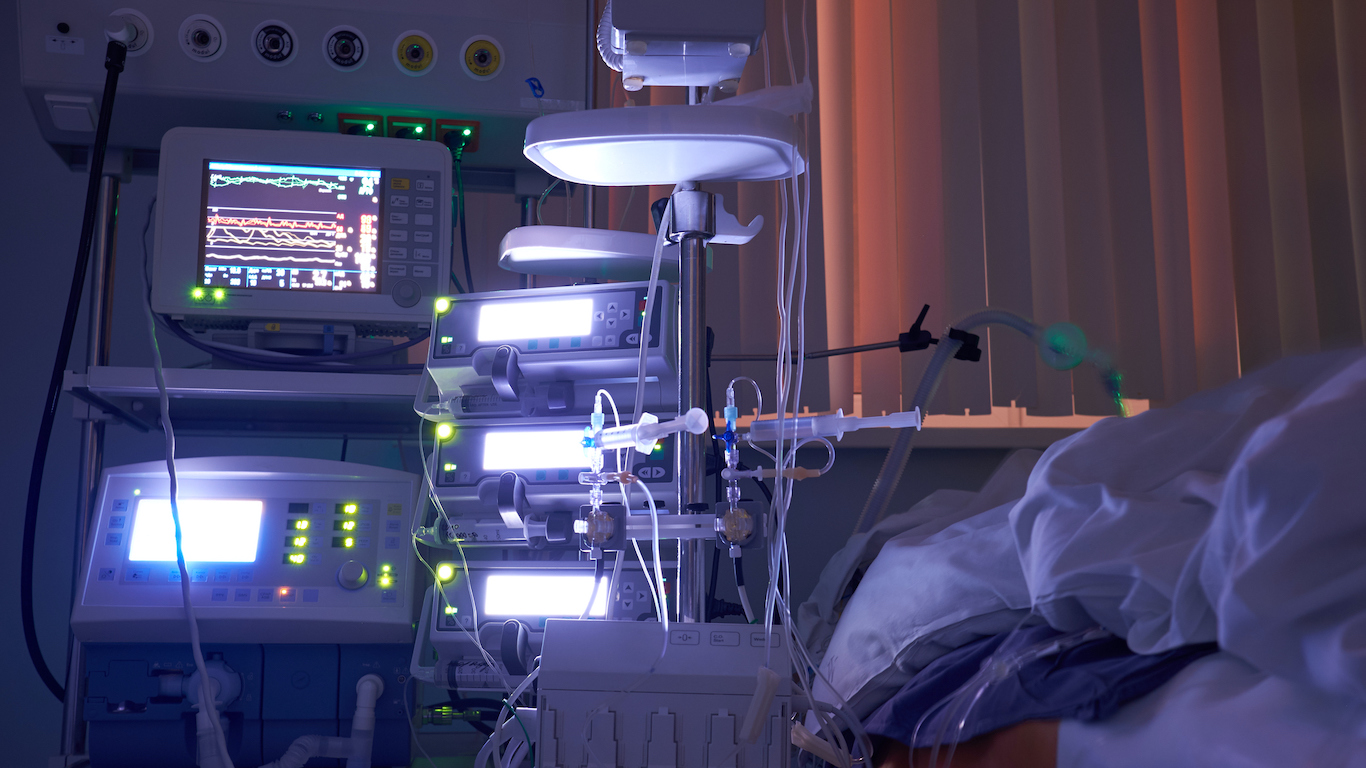
Published:

Nearly 8% of the U.S. population needed an overnight stay in a hospital in 2018. While a full and speedy recovery following treatment depends on several factors, including the nature of the illness, the quality of medical care at the hospital can play a significant role.
There are more than 6,100 hospitals in the United States, and not all of them provide the same quality of care. While it is difficult to precisely determine the quality of a health care system, there are certain measures that can be indicative of overall quality of care.
24/7 Tempo created an index of three such measures — hospital readmission rate, hospital mortality rate, and the rate of preventable hospitalizations — reviewed at the metro area level to identify the cities with the worst health care system outcomes.
The quality of hospital care and appropriate follow-up after discharge can influence the measures that make up the index, but factors such as the type of patients that need medical treatment appear to play a role as well.
Socioeconomic characteristics of residents of a metro area appear to have an impact on the measures used to rate health care system performance, including those related to personal health. For example, unhealthy patient behaviors such as smoking, sedentary lifestyles, and poor diets can contribute to higher readmission rates and negative health outcomes. In fact, many of the cities on this list have relatively unhealthy populations and high premature mortality rates — these are the least healthy cities in every state.
Additionally, the majority of metro areas on this list, have far lower household incomes than the typical American household. Economically disadvantaged areas may have less effective health care systems because of fewer resources and an insufficient number of doctors in an area — these are the states with the fewest and most doctors per person.
Click here to see the 25 cities where you don’t want to get sick
Click here to read our methodology
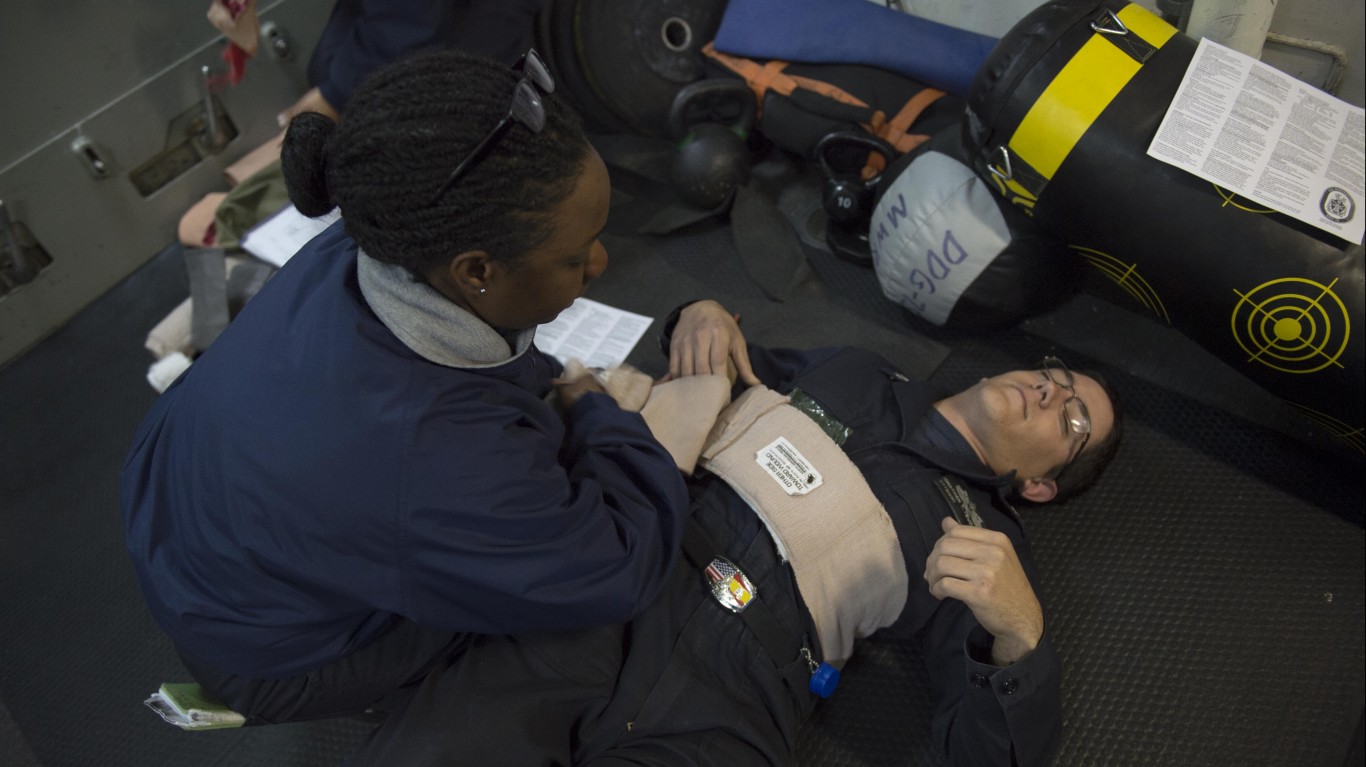
25. Port St. Lucie, Florida
> 30-day hospital readmission rate: 17.6% (national rate: 15.3%)
> Mortality within 30 days of hospitalization: 12.1% (national rate: 12.4%)
> Preventable hospitalizations: 55 per 1,000 Medicare enrollees (national rate: 45 per 1,000)
> No. of primary care physicians: 48 per 100,000 residents (national rate: 75 per 100,000)
> Median household income: $62,608 (national median: $65,712)
In Port St. Lucie, Florida, 17.6% of Medicare enrollees are hospitalized again within 30 days of their discharge, the largest share of any other metro area in the country. High 30-day readmission rates can sometimes be indicative of lower quality care in area hospitals.
The area’s poor performance in measures of quality of care may be partially due to an overreliance on hospitals as a primary treatment option. There are about 55 hospitalizations for conditions that should have been treated in an outpatient setting for every 1,000 Medicare enrollees in Port St. Lucie, a higher preventable hospitalization rate than in the vast majority of U.S. metro areas and well above the national rate of 45 preventable hospitalizations per 1,000.
[in-text-ad]

24. Monroe, Michigan
> 30-day hospital readmission rate: 16.5% (national rate: 15.3%)
> Mortality within 30 days of hospitalization: 12.5% (national rate: 12.4%)
> Preventable hospitalizations: 58 per 1,000 Medicare enrollees (national rate: 45 per 1,000)
> No. of primary care physicians: 29 per 100,000 residents (national rate: 75 per 100,000)
> Median household income: $62,839 (national median: $65,712)
One factor affecting the quality of health care in Monroe, Michigan, may be the relative lack of doctors in the metro area. There are not even 30 primary care physicians per 100,000 residents in Monroe, less than half the national concentration of 75 doctors per 100,000 Americans. With less access to outpatient treatment, Monroe residents may be more likely to visit the hospital for primary care conditions, putting unnecessary strain on hospital resources. There are 58 preventable hospitalizations per 1,000 Medicare enrollees in the area annually, a higher share than most cities in the country and far above the national rate of 45 per 1,000.
Monroe is the only metro area in Michigan — and one of only five metro areas in the Midwest — to rank on this list.

23. Monroe, Louisiana
> 30-day hospital readmission rate: 16.3% (national rate: 15.3%)
> Mortality within 30 days of hospitalization: 11.9% (national rate: 12.4%)
> Preventable hospitalizations: 67 per 1,000 Medicare enrollees (national rate: 45 per 1,000)
> No. of primary care physicians: 74 per 100,000 residents (national rate: 75 per 100,000)
> Median household income: $40,136 (national median: $65,712)
One of the main indicators of hospital quality is the share of patients being readmitted after discharge. Readmissions can occur due to poor post-acute care, medical complications during initial hospital stays, poor patient discharge guidance, or for other, non-preventable medical reasons. In Monroe, Louisiana, 15.2% of coronary artery bypass surgery patients are readmitted to the hospital after 30 days, the eighth largest share of any U.S. metro area. Additionally, 22.7% of patients with heart failure return to the hospital within 30 days of discharge, a higher share than most metro areas and higher than the national share of 21.6%.
Another measure of health care quality is the number of patients hospitalized for conditions that are treatable in an outpatient setting — often an indication of poor outpatient treatment. In Monroe, there are 67 preventable hospitalizations per 1,000 Medicare enrollees, the 13th highest preventable hospitalization rate in the country.
22. Terre Haute, Indiana
> 30-day hospital readmission rate: 15.7% (national rate: 15.3%)
> Mortality within 30 days of hospitalization: 11.8% (national rate: 12.4%)
> Preventable hospitalizations: 72 per 1,000 Medicare enrollees (national rate: 45 per 1,000)
> No. of primary care physicians: 74 per 100,000 residents (national rate: 75 per 100,000)
> Median household income: $50,129 (national median: $65,712)
In Terre Haute, Indiana, a larger than typical share of residents are hospitalized for conditions that could or should have been treated in an outpatient setting. There are about 72 preventable hospitalizations for every 1,000 Medicare enrollees in the metro area, the fifth highest rate of any metro area, and far higher than the national rate of 45 per 1,000.
As is the case in most metro areas on this list, incomes in Terre Haute tend to be lower than they are nationwide. The median annual household income in the metro area is $50,129, lower than the majority of U.S. cities and well below the national median of $65,715.
[in-text-ad-2]
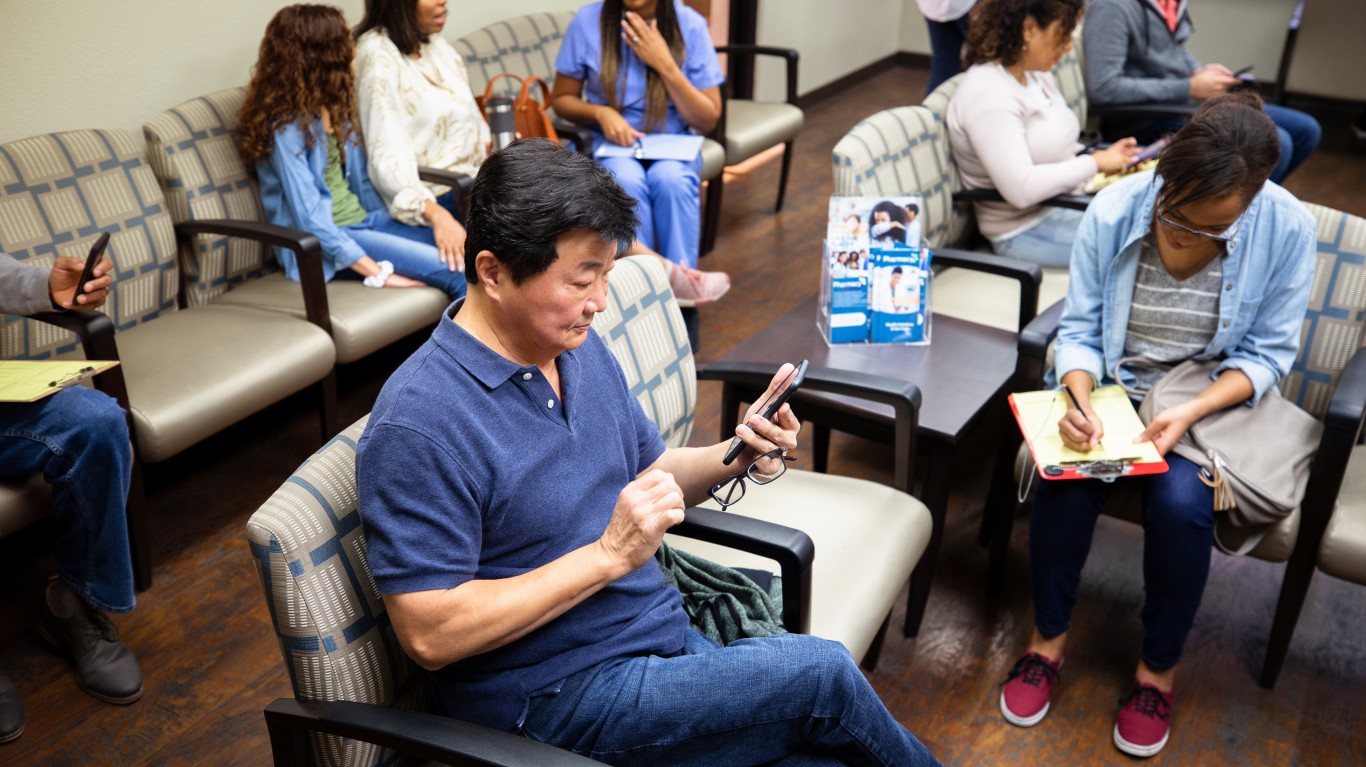
21. Sebring, Florida
> 30-day hospital readmission rate: 16.2% (national rate: 15.3%)
> Mortality within 30 days of hospitalization: 12.5% (national rate: 12.4%)
> Preventable hospitalizations: 62 per 1,000 Medicare enrollees (national rate: 45 per 1,000)
> No. of primary care physicians: 59 per 100,000 residents (national rate: 75 per 100,000)
> Median household income: $48,698 (national median: $65,712)
Residents of Sebring, Florida, are more likely to be admitted to the hospital for conditions that should have been treated in an outpatient setting. Such preventable hospitalizations add undue strain on the local health care system, which in Sebring is already likely strained due to the relative scarcity of doctors.
There are only 59 doctors for every 100,000 people in Sebring, a far lower concentration than the comparable national average of 75 physicians for every 100,000 people.
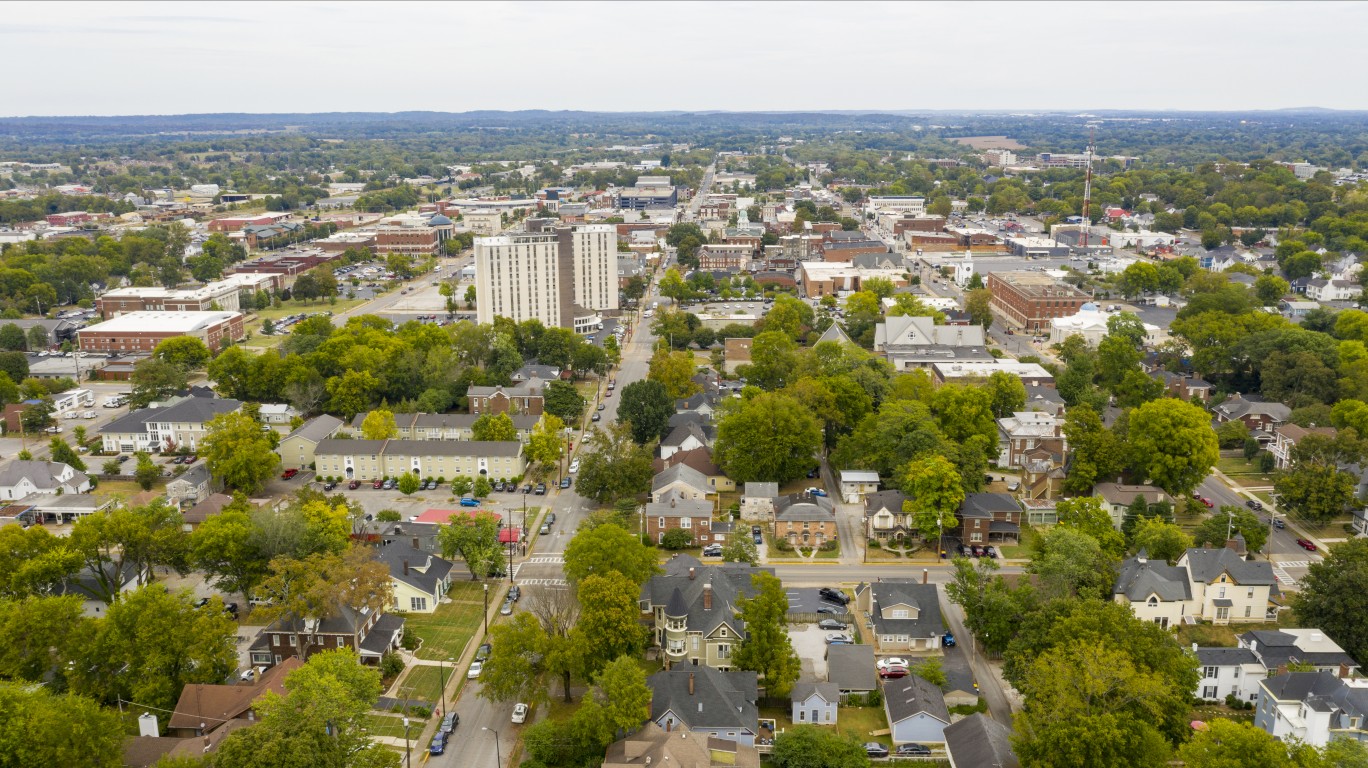
20. Bowling Green, Kentucky
> 30-day hospital readmission rate: 16.3% (national rate: 15.3%)
> Mortality within 30 days of hospitalization: 12.8% (national rate: 12.4%)
> Preventable hospitalizations: 59 per 1,000 Medicare enrollees (national rate: 45 per 1,000)
> No. of primary care physicians: 55 per 100,000 residents (national rate: 75 per 100,000)
> Median household income: $51,198 (national median: $65,712)
In Bowling Green, Kentucky, people are more likely than most Americans to be admitted to the hospital for conditions that could have been treated in an outpatient setting. These preventable hospitalizations add undue strain on the local health care system, taking resources from those for whom hospitalization is necessary.
As it is, Bowling Green has relatively few primary care physicians for its population size. There are only 55 doctors for every 100,000 people in Bowling Green, a far lower concentration than the national average of 75 physicians for every 100,000 people.
[in-text-ad]

19. Springfield, Illinois
> 30-day hospital readmission rate: 16.1% (national rate: 15.3%)
> Mortality within 30 days of hospitalization: 14.2% (national rate: 12.4%)
> Preventable hospitalizations: 46 per 1,000 Medicare enrollees (national rate: 45 per 1,000)
> No. of primary care physicians: 115 per 100,000 residents (national rate: 75 per 100,000)
> Median household income: $62,205 (national median: $65,712)
In Springfield, Illinois, people who are hospitalized after suffering strokes, heart attacks, pneumonia, and COPD are more likely to die than Americans hospitalized with these conditions nationwide. An estimated 14.2% of metro area Medicare enrollees who are treated in a hospital die within 30 days of admission, compared to 12.4% of Medicare recipients nationwide who do.
Springfield residents are also far more likely to have to be readmitted to the hospital within a month of discharge than Americans in the vast majority of U.S. metro areas. Springfield’s 30-day readmission rate is 16.1%, compared to the national readmission rate of 15.3%.

18. Mobile, Alabama
> 30-day hospital readmission rate: 15.6% (national rate: 15.3%)
> Mortality within 30 days of hospitalization: 13.1% (national rate: 12.4%)
> Preventable hospitalizations: 64 per 1,000 Medicare enrollees (national rate: 45 per 1,000)
> No. of primary care physicians: 67 per 100,000 residents (national rate: 75 per 100,000)
> Median household income: $49,561 (national median: $65,712)
There are only about 67 primary care physicians for every 100,000 people in Mobile, Alabama, a lower concentration than the national average of 75 per 100,000. An inadequate number of doctors in a city can make it more difficult to seek necessary preventive and primary care, which can lead to an overreliance on hospitals. In Mobile, a larger than typical share of residents are hospitalized for conditions that could or should have been treated in an outpatient setting. There are about 64 preventable hospitalizations for every 1,000 Medicare enrollees in the metro area, compared to 45 per 1,000 nationwide.
Mobile residents are more likely to earn lower incomes than the typical American. The median annual household income in Mobile is $49,561, well below the national median of $65,712.
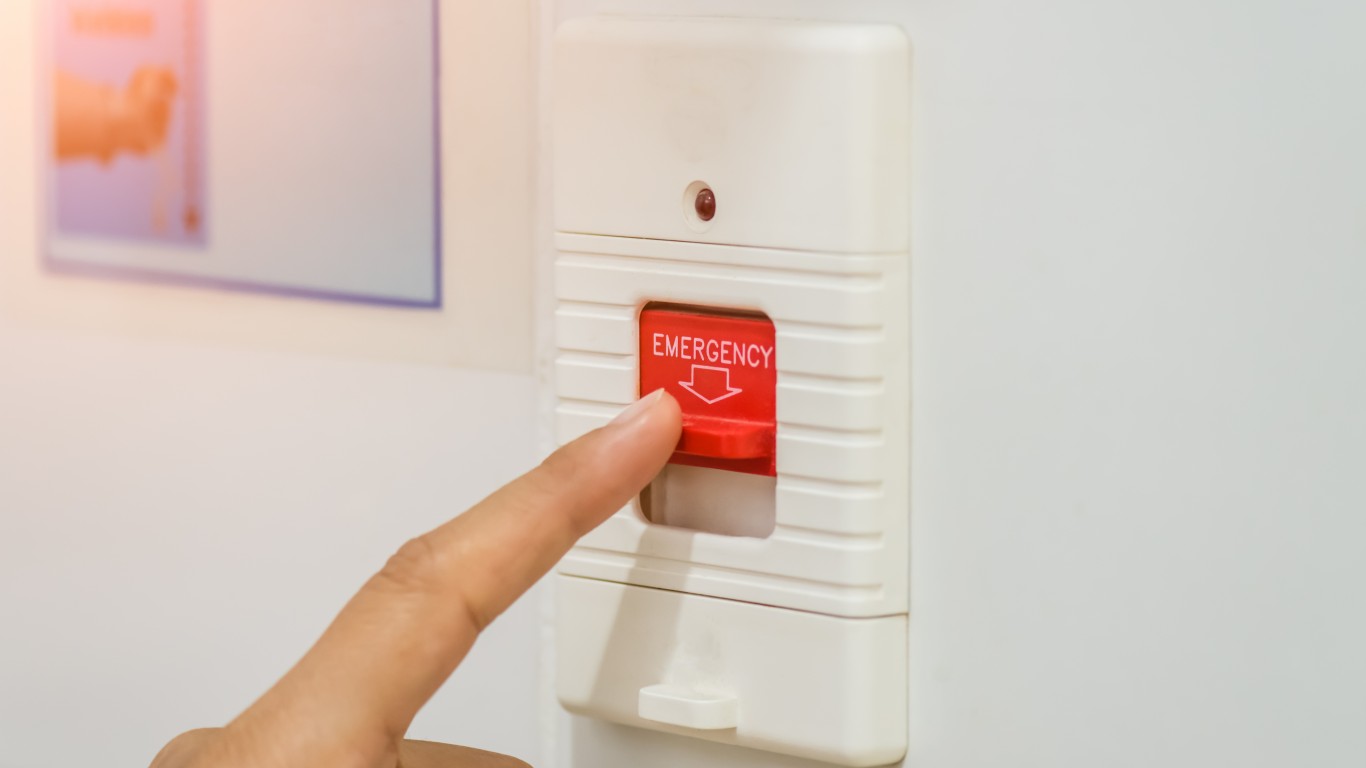
17. Goldsboro, North Carolina
> 30-day hospital readmission rate: 15.7% (national rate: 15.3%)
> Mortality within 30 days of hospitalization: 14.3% (national rate: 12.4%)
> Preventable hospitalizations: 53 per 1,000 Medicare enrollees (national rate: 45 per 1,000)
> No. of primary care physicians: 47 per 100,000 residents (national rate: 75 per 100,000)
> Median household income: $44,596 (national median: $65,712)
Along with Rocky Mount, Goldsboro is one of two North Carolina metro areas to rank on this list. In Goldsboro, some 14.3% of patents die within 30 days of being admitted to a hospital, a higher share than most metro areas in the country and well above the corresponding 12.4% national rate. Additionally, there are only 47 primary care doctors per 100,000 residents in Goldsboro, well below the national concentration of 75 doctors per 100,000.
Wealthier Americans can better afford regular, preventative health care and a greater range of healthy options related to diet and lifestyle. As a result, income is closely linked to health outcomes. The median annual household income in Goldsboro is among the lowest in the country at just $44,596, or over $20,000 below the national median of $65,712.
[in-text-ad-2]
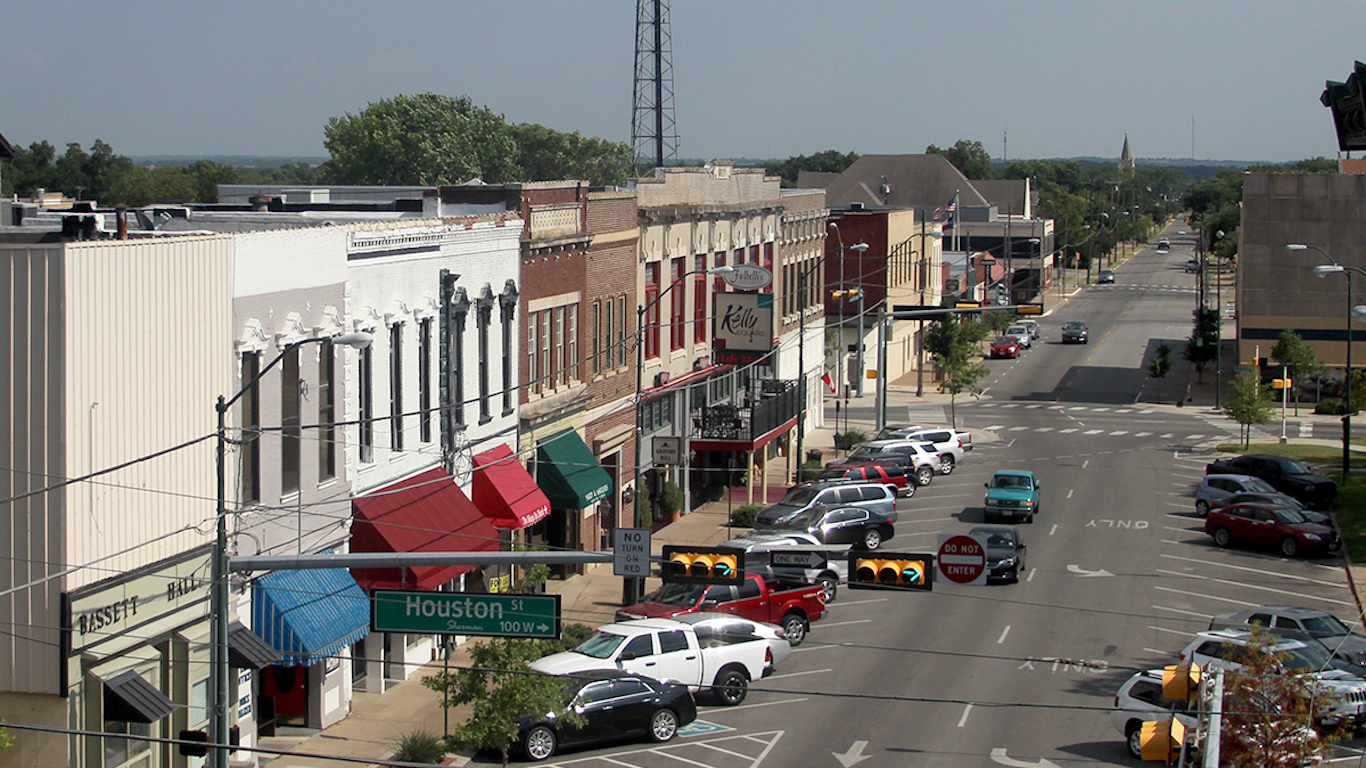
16. Sherman-Denison, Texas
> 30-day hospital readmission rate: 16.7% (national rate: 15.3%)
> Mortality within 30 days of hospitalization: 11.6% (national rate: 12.4%)
> Preventable hospitalizations: 72 per 1,000 Medicare enrollees (national rate: 45 per 1,000)
> No. of primary care physicians: 47 per 100,000 residents (national rate: 75 per 100,000)
> Median household income: $57,476 (national median: $65,712)
In the Sherman-Denison, Texas, metro area, people are more likely than most Americans to be admitted to the hospital for conditions that could have been treated in an outpatient setting. These preventable hospitalizations add undue strain on the local health care system, taking resources from those for whom hospitalization is necessary. There are 72 preventable hospitalizations for every 1,000 Medicare enrollees in the metro area, well above the national rate of 45 per 1,000.

15. Gadsden, Alabama
> 30-day hospital readmission rate: 15.9% (national rate: 15.3%)
> Mortality within 30 days of hospitalization: 11.9% (national rate: 12.4%)
> Preventable hospitalizations: 74 per 1,000 Medicare enrollees (national rate: 45 per 1,000)
> No. of primary care physicians: 81 per 100,000 residents (national rate: 75 per 100,000)
> Median household income: $41,447 (national median: $65,712)
One indication of poor hospital quality is high patient readmission. Some of the reasons readmissions can occur are medical complications during the initial hospital stay or inadequate patient discharge instructions. In Gadsden, 24.6% of all heart failure patients return to the hospital within 30 days of discharge, the fifth highest share of any metro area.
Additionally, Gadsden has the fourth highest preventable hospitalization rate of all metro areas at 74 per 1,000 Medicare enrollees, far higher than the national rate of 45 per 1,000.
[in-text-ad]

14. Albany, Georgia
> 30-day hospital readmission rate: 15.2% (national rate: 15.3%)
> Mortality within 30 days of hospitalization: 15.6% (national rate: 12.4%)
> Preventable hospitalizations: 54 per 1,000 Medicare enrollees (national rate: 45 per 1,000)
> No. of primary care physicians: 63 per 100,000 residents (national rate: 75 per 100,000)
> Median household income: $40,625 (national median: $65,712)
Albany, Georgia, has nearly the highest post-hospitalization mortality rate of any U.S. metro area. An estimated 15.6% of residents who are hospitalized for a wide range of conditions die within 30 days after admission, a far larger share than the national 12.4% 30-day mortality rate.
Albany also has far fewer doctors relative to the size of its population than the U.S. as a whole. Across the country, there are 75 primary care physicians for every 100,000 people, compared to just 63 per 100,000 in Albany.
13. Hot Springs, Arkansas
> 30-day hospital readmission rate: 16.6% (national rate: 15.3%)
> Mortality within 30 days of hospitalization: 14.0% (national rate: 12.4%)
> Preventable hospitalizations: 47 per 1,000 Medicare enrollees (national rate: 45 per 1,000)
> No. of primary care physicians: 88 per 100,000 residents (national rate: 75 per 100,000)
> Median household income: $45,265 (national median: $65,712)
In Hot Springs, Arkansas, people who are hospitalized after suffering heart attacks or with pneumonia are more likely to die than most Americans hospitalized for such conditions. An estimated 14.9% of metro area Medicare enrollees who are treated in a hospital for a heart attack die within 30 days of admission, the eighth largest share among metro areas, compared to 12.9% of enrollees nationwide who do. Nearly one in five pneumonia patients die within 30 days of being admitted, the ninth highest share in the country and well above the national rate of 15.6%.
Hot Springs residents are also far more likely to have to be readmitted to the hospital within a month of discharge than Americans in the vast majority of U.S. metro areas. The city’s 30-day readmission rate is 16.6%, the 10th highest among all metro areas reviewed and higher than the national average of 15.3%.

12. Johnstown, Pennsylvania
> 30-day hospital readmission rate: 16.2% (national rate: 15.3%)
> Mortality within 30 days of hospitalization: 13.4% (national rate: 12.4%)
> Preventable hospitalizations: 59 per 1,000 Medicare enrollees (national rate: 45 per 1,000)
> No. of primary care physicians: 81 per 100,000 residents (national rate: 75 per 100,000)
> Median household income: $49,076 (national median: $65,712)
As is the case in most metro areas on this list, Johnston, Pennsylvania, has a high patient readmission rate. While readmissions are often no fault of the hospital, they can occur due to poor post-acute care, medical complications during initial hospital stays, or inadequate patient discharge guidance. In Johnstown, 16.2% of all hospital patients return within 30 days of discharge, compared to a national rate of 15.3%.
Additionally, despite having more than the national average number of doctors per 100,000 people, Johnston residents are more likely to be admitted for conditions that should have been treated in an outpatient setting than the typical American. The preventable hospitalization rate for the metro area is 59 per 1,000 Medicare enrollees, compared to a national rate of 45 per 1,000.
[in-text-ad-2]
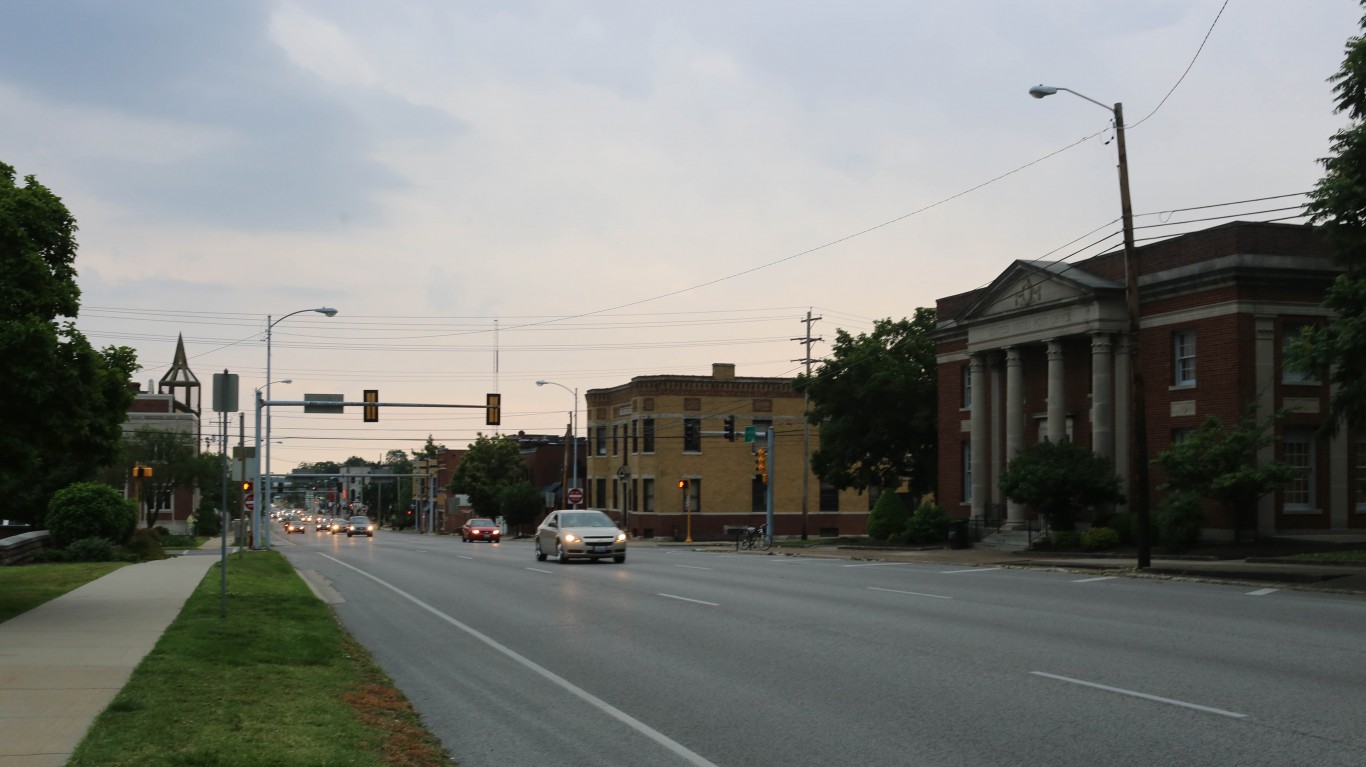
11. Carbondale-Marion, Illinois
> 30-day hospital readmission rate: 17.1% (national rate: 15.3%)
> Mortality within 30 days of hospitalization: 12.9% (national rate: 12.4%)
> Preventable hospitalizations: 58 per 1,000 Medicare enrollees (national rate: 45 per 1,000)
> No. of primary care physicians: 106 per 100,000 residents (national rate: 75 per 100,000)
> Median household income: $46,882 (national median: $65,712)
Carbondale-Marion, Illinois, has one of the highest readmission rates of any metro area in the United States. An estimated 17.1% of local Medicare recipients are readmitted to the hospital within about a month of their initial discharge to the hospital, well above the 15.3% national readmission rate.
Many hospitalizations in Carbondale-Marion are for conditions that could or should have been treated in an outpatient setting. There are 58 preventable hospitalizations for every 1,000 Medicare enrollees in the metro area, well above the 45 per 1,000 national preventable hospitalization rate. These preventable hospitalizations add undue strain on hospital resources.
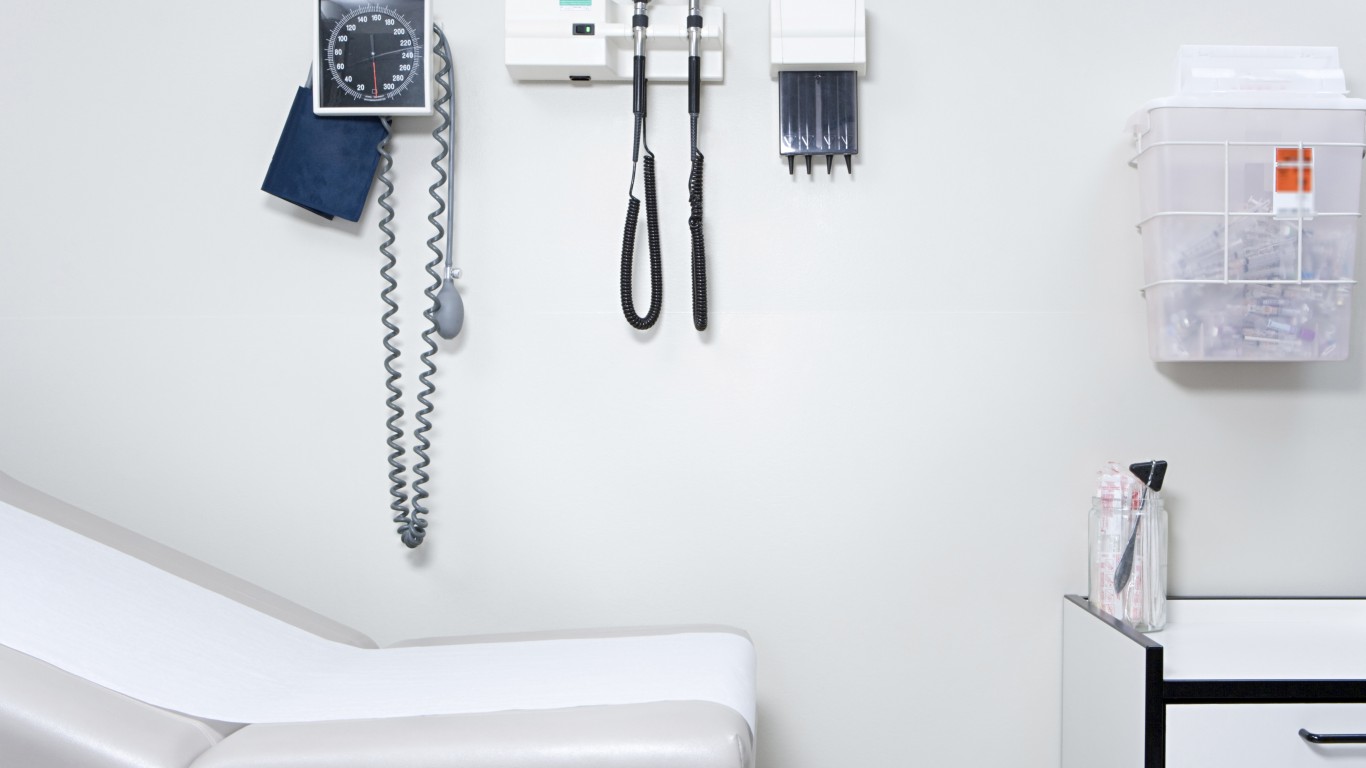
10. Beckley, West Virginia
> 30-day hospital readmission rate: 15.7% (national rate: 15.3%)
> Mortality within 30 days of hospitalization: 12.5% (national rate: 12.4%)
> Preventable hospitalizations: 76 per 1,000 Medicare enrollees (national rate: 45 per 1,000)
> No. of primary care physicians: 72 per 100,000 residents (national rate: 75 per 100,000)
> Median household income: $44,785 (national median: $65,712)
Beckley is one of three metro areas in West Virginia to rank on this list. One of the main indicators of hospital quality is the share of patients being readmitted shortly after discharge. In Beckley, 24.1% of all heart failure patients are readmitted to the hospital 30 days after discharge, the ninth largest share of any U.S. metro area. Additionally, 17.0% of patients who had suffered a heart attack return to the hospital within a month of discharge, the 16th largest share among U.S. metro areas.
Another measure of health care quality is the number of patients hospitalized for conditions that are treatable in an outpatient setting — often an indication of poor outpatient treatment. In Beckley, there are 76 preventable hospitalizations per 1,000 Medicare enrollees, the third highest preventable hospitalization rate in the country.
[in-text-ad]

9. Gulfport-Biloxi-Pascagoula, Mississippi
> 30-day hospital readmission rate: 16.1% (national rate: 15.3%)
> Mortality within 30 days of hospitalization: 13.6% (national rate: 12.4%)
> Preventable hospitalizations: 62 per 1,000 Medicare enrollees (national rate: 45 per 1,000)
> No. of primary care physicians: 50 per 100,000 residents (national rate: 75 per 100,000)
> Median household income: $50,642 (national median: $65,712)
Gulfport-Biloxi-Pascagoula, Mississippi, has far fewer doctors relative to its population size than much of the rest of the country. There are only 50 primary care physicians for every 100,000 metro area residents, compared to 75 per 100,000 nationwide.
A lack of primary care physicians may partially explain why metro area residents are more likely to go to the hospital for conditions that should be treated in an outpatient facility. There are an estimated 62 preventable hospitalizations for every 1,000 Medicare enrollees in the metro area, well above the 45 per 1,000 national preventable hospitalization rate.
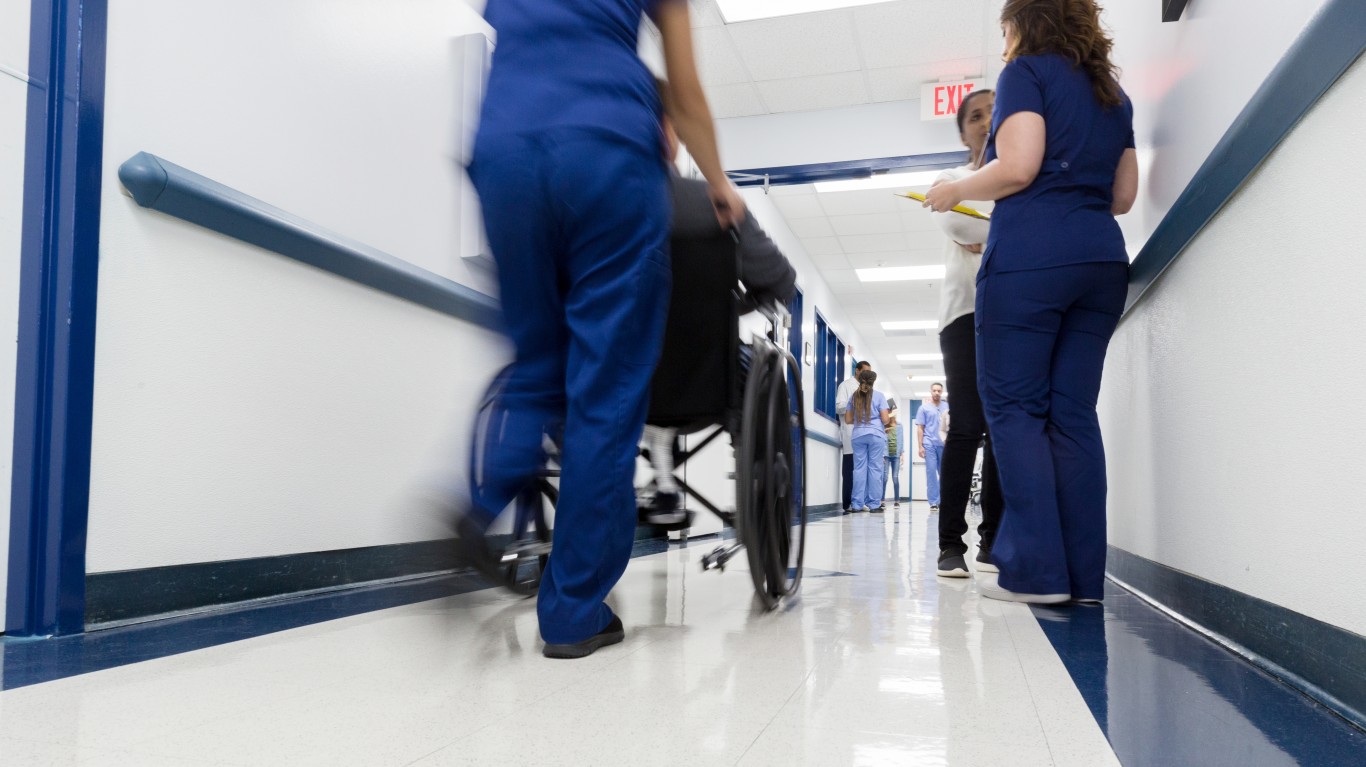
8. Wheeling, West Virginia-Ohio
> 30-day hospital readmission rate: 15.5% (national rate: 15.3%)
> Mortality within 30 days of hospitalization: 12.9% (national rate: 12.4%)
> Preventable hospitalizations: 80 per 1,000 Medicare enrollees (national rate: 45 per 1,000)
> No. of primary care physicians: 74 per 100,000 residents (national rate: 75 per 100,000)
> Median household income: $50,440 (national median: $65,712)
In Wheeling, the incidence of hospital readmission, post-treatment mortality, and preventable hospitalization is worse than the nation as a whole.
Adjusted for risk factors such as age, patient health, and the presence of other illnesses, patients in Wheeling are more likely than the average patient to die within a month after being admitted to a hospital. Some 13.3% of heart failure patients die within 30 days of being admitted to the hospital, a higher share than the vast majority of U.S. metro areas. Additionally, Wheeling has the second highest preventable hospitalization rate of U.S. metro areas. About 80 hospitalized patients per 1,000 Medicare enrollees should have been treated in an outpatient facility, compared to 45 per 1,000 in the country as a whole.

7. Rocky Mount, North Carolina
> 30-day hospital readmission rate: 16.3% (national rate: 15.3%)
> Mortality within 30 days of hospitalization: 13.5% (national rate: 12.4%)
> Preventable hospitalizations: 65 per 1,000 Medicare enrollees (national rate: 45 per 1,000)
> No. of primary care physicians: 48 per 100,000 residents (national rate: 75 per 100,000)
> Median household income: $46,466 (national median: $65,712)
Rocky Mount, North Carolina, has one of the highest preventable hospitalization rates in the country. There are an estimated 65 hospitalizations for diagnosis that are typically treated in an outpatient facility for every 1,000 Medicare enrollees annually, well above the 45 per 1,000 national rate. A high rate of preventable hospitalizations can be indicative of subpar care in outpatient facilities and also an overuse of urgent care and emergency rooms, which can be a significant burden on hospital resources.
[in-text-ad-2]

6. Parkersburg-Vienna, West Virginia
> 30-day hospital readmission rate: 16.5% (national rate: 15.3%)
> Mortality within 30 days of hospitalization: 13.1% (national rate: 12.4%)
> Preventable hospitalizations: 69 per 1,000 Medicare enrollees (national rate: 45 per 1,000)
> No. of primary care physicians: 78 per 100,000 residents (national rate: 75 per 100,000)
> Median household income: $48,680 (national median: $65,712)
Parkersburg-Vienna is one of three West Virginia metro areas to rank among the 10 worst cities for sick people. Poorer areas tend to have underperforming hospital systems and worse health care overall. In the Parkersburg-Vienna metro area, the typical household earns just $48,860 a year, about $17,000 less than the U.S. median.
One indication of poor hospital quality can be high patient readmission. While many hospital readmissions are non-preventable, many are due to poor post-acute care or medical complications during initial treatment. In Parkersburg, 16.5% of all patients return to the hospital within 30 days of discharge, the 12th largest share of any U.S. metro area. The area’s preventable hospitalization rate is also among the highest in the country, at 69 per 1,000 Medicare enrollees, compared to a national rate of 45 per 1,000.

5. Jackson, Tennessee
> 30-day hospital readmission rate: 15.6% (national rate: 15.3%)
> Mortality within 30 days of hospitalization: 14.7% (national rate: 12.4%)
> Preventable hospitalizations: 64 per 1,000 Medicare enrollees (national rate: 45 per 1,000)
> No. of primary care physicians: 103 per 100,000 residents (national rate: 75 per 100,000)
> Median household income: $48,700 (national median: $65,712)
The mortality rate of patients within 30 days of being admitted to a hospital in Jackson, Tennessee, is among the highest of all U.S. metro areas. Some 14.7% of patients discharged from metro area hospitals die within a month, a higher share than in all but 11 other U.S. metro areas. The 30-day mortality rates for patients treated for pneumonia and for those with COPD are particularly high, at 20.0% (the second highest) and 11.6% (the fourth highest), respectively compared to 15.6% and 8.5% nationwide.
Though Jackson has among the most primary case physicians per capita, the area’s preventable hospitalizations rate of 64 per 1,000 Medicare enrollees is higher than the vast majority of U.S. metro areas and higher than the national rate of 45 per 1,000.
[in-text-ad]
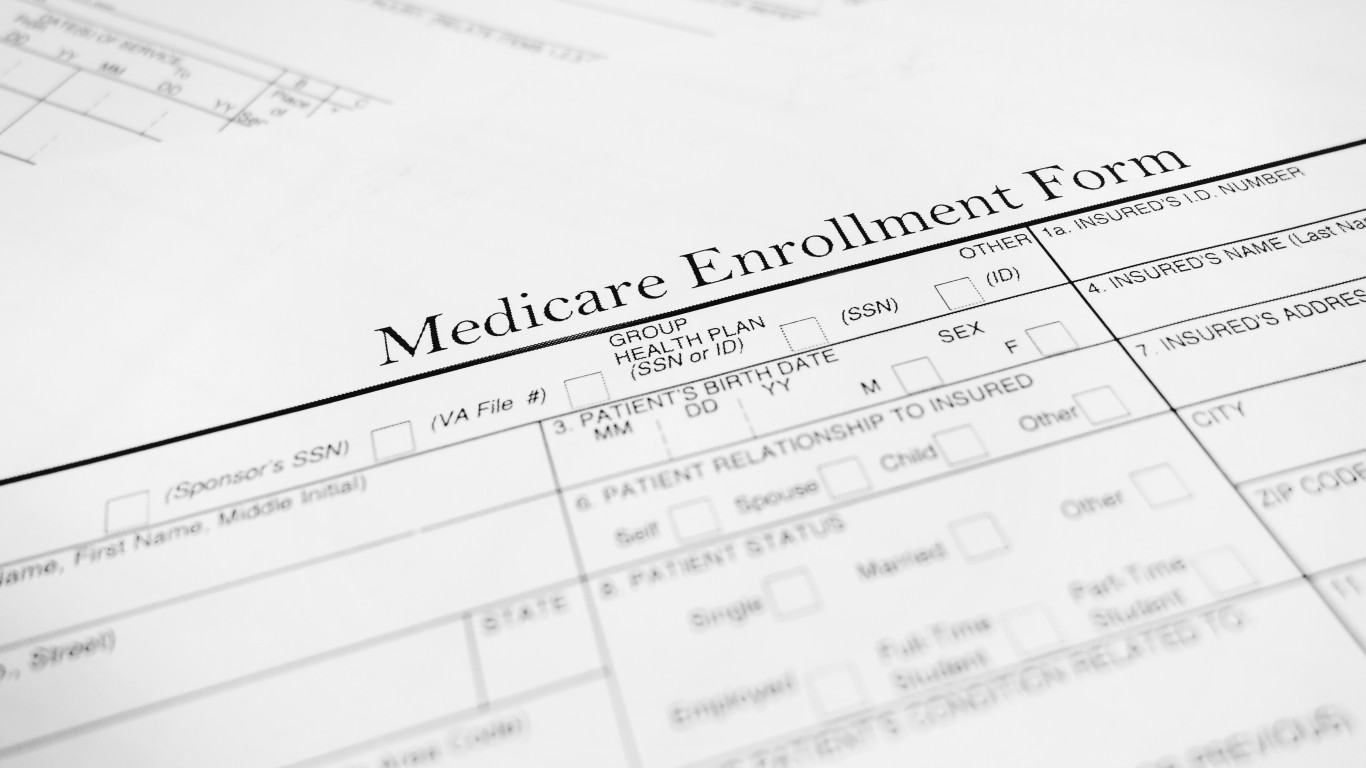
4. Jonesboro, Arkansas
> 30-day hospital readmission rate: 17.0% (national rate: 15.3%)
> Mortality within 30 days of hospitalization: 13.8% (national rate: 12.4%)
> Preventable hospitalizations: 61 per 1,000 Medicare enrollees (national rate: 45 per 1,000)
> No. of primary care physicians: 98 per 100,000 residents (national rate: 75 per 100,000)
> Median household income: $44,998 (national median: $65,712)
Medicare enrollees living in Jonesboro, Arkansas, are far more likely than average to be readmitted to a hospital within a month of their initial admission. An estimated 17.0% of Medicare recipients in the metro area who are hospitalized have to be readmitted for care within 30 days of their initial care period. This can often indicate low quality of care. Additionally, about 13.8% of those hospitalized for certain serious conditions in Jonesboro die within 30 days after admission, well above the national mortality rate after 30 day of 12.4%.

3. Dubuque, Iowa
> 30-day hospital readmission rate: 15.0% (national rate: 15.3%)
> Mortality within 30 days of hospitalization: 12.8% (national rate: 12.4%)
> Preventable hospitalizations: 94 per 1,000 Medicare enrollees (national rate: 45 per 1,000)
> No. of primary care physicians: 79 per 100,000 residents (national rate: 75 per 100,000)
> Median household income: $62,178 (national median: $65,712)
Dubuque, Iowa, is one of only five metro areas in the Midwest to rank on this list. Preventable hospitalizations can suggest inadequate outpatient treatment and also overuse of hospitals as a primary source of care. In Dubuque, about 94 Medicare enrollees for every 1,000 are hospitalized for conditions that could or should have been treated in an outpatient setting, by far the highest preventable hospitalization rate of any metro area in the United States.
Despite the nation-leading preventable hospitalization rate and the unnecessary additional strain that such hospitalizations impose on facilities, by some measures, hospitals in Dubuque perform relatively well. For example, just 15.0% of those discharged by area hospitals are readmitted within 30 days, a slightly smaller share than the 15.3% national readmission rate, and the mortality rate within a month of admission is 12.8%, only slightly higher than the national rate of 12.4%.
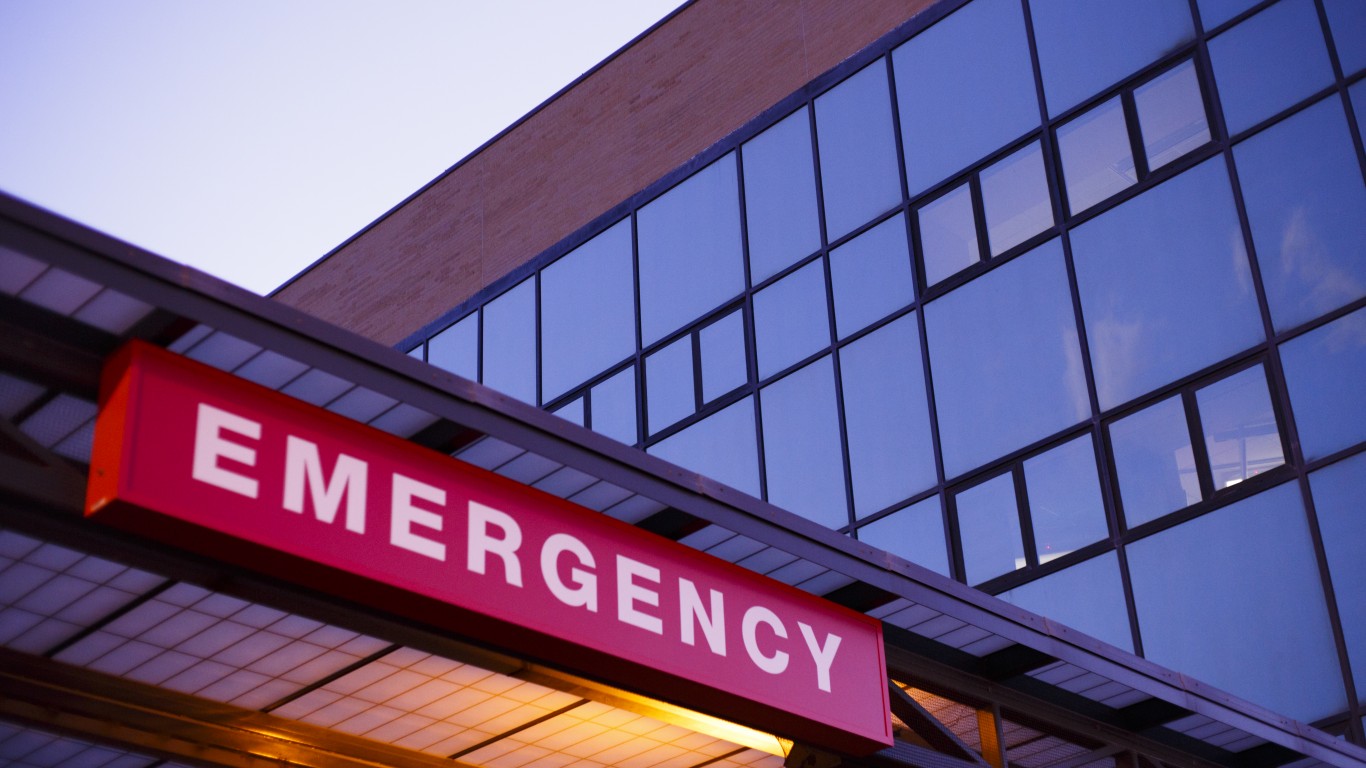
2. Lakeland-Winter Haven, Florida
> 30-day hospital readmission rate: 16.7% (national rate: 15.3%)
> Mortality within 30 days of hospitalization: 13.5% (national rate: 12.4%)
> Preventable hospitalizations: 70 per 1,000 Medicare enrollees (national rate: 45 per 1,000)
> No. of primary care physicians: 49 per 100,000 residents (national rate: 75 per 100,000)
> Median household income: $51,833 (national median: $65,712)
Preventable hospitalizations can be indicative of inadequate primary care facilities and can result in undue strain on hospital resources. In the Lakeland-Winter Haven metro area, there are 70 preventable hospitalizations for every 1,000 Medicare enrollees, well above the 45 per 1,000 national rate.
An over-reliance on emergency rooms and urgent care as a primary means of treatment may be due in part to the relative lack of primary care physicians in the area. There are only 49 primary care physicians in Lakeland-Winter Haven for every 100,000 residents, compared to 75 per 100,000 nationwide.
[in-text-ad-2]
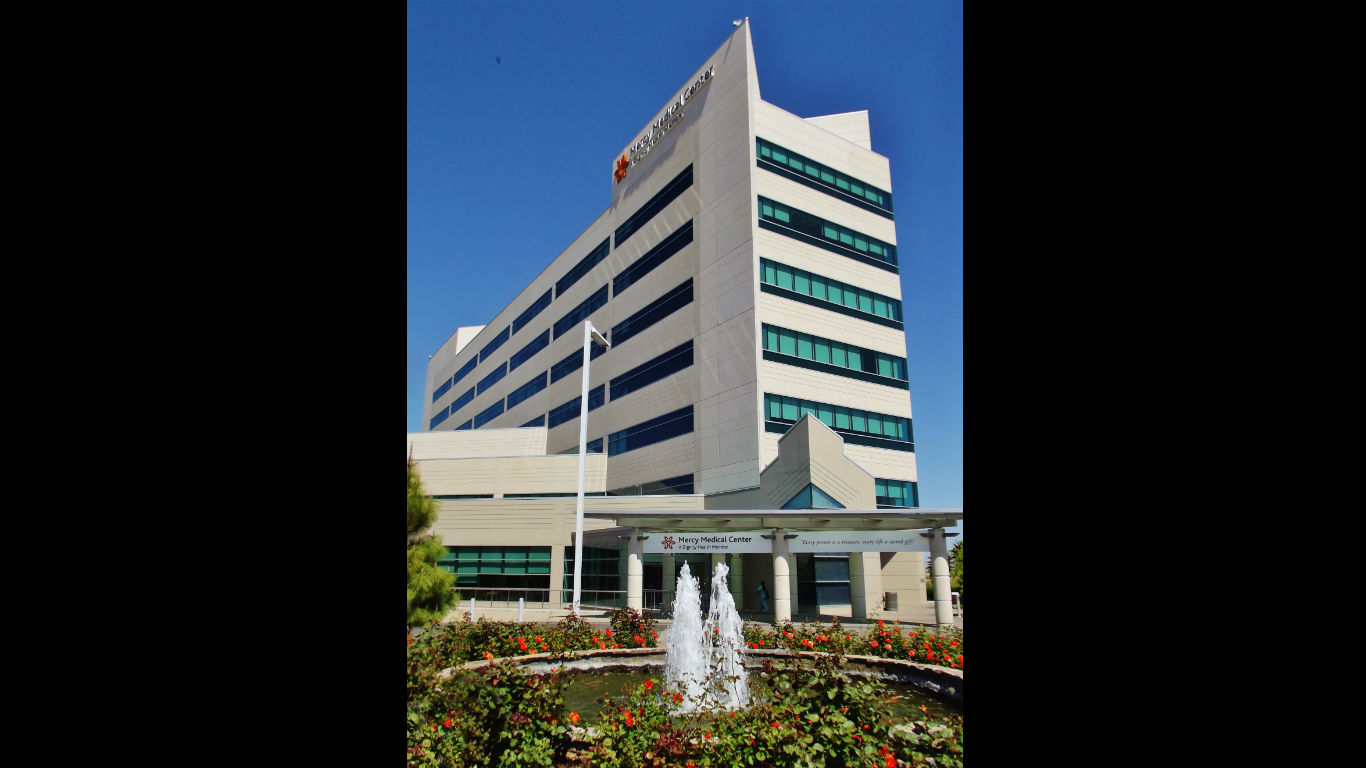
1. Merced, California
> 30-day hospital readmission rate: 17.5% (national rate: 15.3%)
> Mortality within 30 days of hospitalization: 14.3% (national rate: 12.4%)
> Preventable hospitalizations: 54 per 1,000 Medicare enrollees (national rate: 45 per 1,000)
> No. of primary care physicians: 44 per 100,000 residents (national rate: 75 per 100,000)
> Median household income: $61,167 (national median: $65,712)
In the Merced, California, metro area, 17.5% of all hospital patients who are discharged are readmitted within 30 days, the second highest readmission rate of any metro area in the United States. Though the majority of unplanned hospital readmissions are not preventable, an especially high readmission rate can be indicative of poor quality hospital care. The mortality rate within 30 days of being admitted is also among the highest in the country, at 14.3%, compared to 12.4% nationwide.
Adequate physician availability is critical to receiving necessary care, and there are relatively few doctors in the Merced metro area. There are only about 44 primary care physicians for every 100,000 people in Merced, one of the smallest concentrations of doctors among U.S. metro areas and well below the national concentration of 75 per 100,000.
Methodology
To determine the cities where you don’t want to get sick, 24/7 Tempo created an index evaluating hospital quality using data for U.S. metropolitan statistical areas from the Centers for Medicare and Medicaid Services (CMS) and County Health Rankings, an annual analysis produced by the Robert Wood Johnson Foundation and University of Wisconsin Population Health Institute joint program. The index measures three sets of indicators: 30-day mortality rates after hospital admittance, 30-day readmission rates, and preventable hospitalizations. Mortality and readmission rates each make up 42.1% of the index, and the rate of preventable hospitalizations makes up the remaining 15.8%.
The CMS produces statistics on numerous health measures for more than 4,000 Medicare-certified hospitals in the country. We grouped hospitals by metropolitan areas and aggregated the hospital data to the metropolitan statistical area level.
Mortality rates
We calculated a weighted average of 30-day mortality rates for heart attacks, chronic obstructive pulmonary disease (COPD), coronary artery bypass grafting (CABG), heart failure, pneumonia, and stroke patients to find the average percentage of people who died within 30 days of being admitted to a hospital. The CMS adjusted the mortality measures for differences in risk variables such as age, comorbidities — the presence of multiple ailments for a given patient — and patient frailty. CMS estimates the data for 30-day mortality by each condition per hospital from Medicare patients.
Readmission rates
The readmission rate measure estimates unplanned readmission to an acute care hospital within 30 days of being discharged from a hospital for Medicare beneficiaries 65 or older. Patients may have an unplanned readmission for any reason.
Preventable hospitalization
Preventable hospitalization is a measure of the share of hospitalizations for conditions that could have been treated at outpatient or ambulatory care facilities — often referred to as the preventable hospitalization rate. This measure counts hospitalizations for conditions such as asthma, dehydration, or hypertension per 1,000 Medicare enrollees. This data is from the 2019 CHR report.
Income figures are one-year estimates from the U.S. Census Bureau’s 2019 American Community Survey. Population figures are from the Census Bureau’s Population Projections program and are estimates for July 2019. Data on the share of residents living in urban and rural areas comes from the Census Bureau’s 2010 decennial census.
Measures of individual health behaviors and outcomes, including obesity, smoking rates, and sedentary lifestyles, also come from CHR.
After two decades of reviewing financial products I haven’t seen anything like this. Credit card companies are at war, handing out free rewards and benefits to win the best customers.
A good cash back card can be worth thousands of dollars a year in free money, not to mention other perks like travel, insurance, and access to fancy lounges.
Our top pick today pays up to 5% cash back, a $200 bonus on top, and $0 annual fee. Click here to apply before they stop offering rewards this generous.
Flywheel Publishing has partnered with CardRatings for our coverage of credit card products. Flywheel Publishing and CardRatings may receive a commission from card issuers.
Thank you for reading! Have some feedback for us?
Contact the 24/7 Wall St. editorial team.